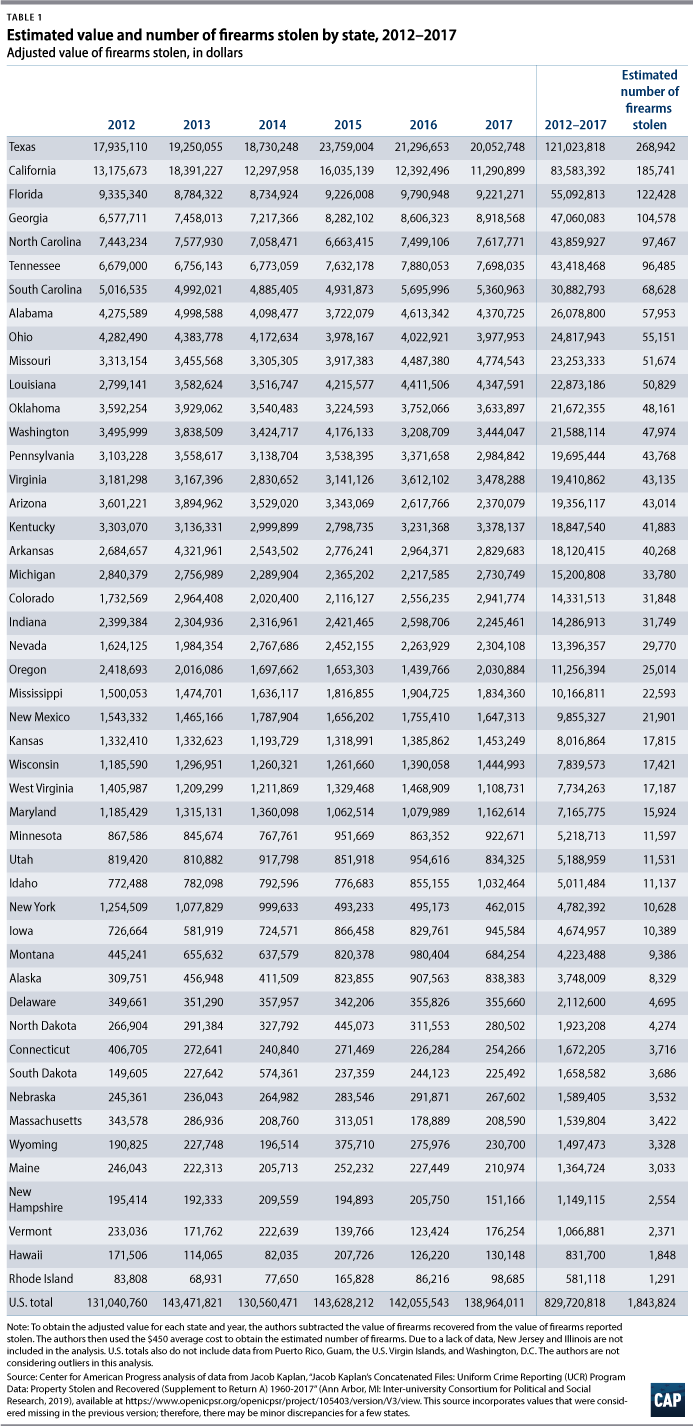This piece is an update to a report released in 2017.
In 2019, six law enforcement officers in Alabama were fatally shot in the line of duty, the highest number in more than 30 years. Five of those shootings were committed with guns that had been stolen from their owners. More recently, in January 2020, a man in Austin, Texas, was shot and killed with a gun that had previously been stolen from a home in a nearby community. And in April 2019, a man who was prohibited from gun possession because of a felony conviction attacked a Veterans Affairs hospital in Chicago, firing shots with a semi-automatic rifle that had been stolen from a gun dealer in Indiana.
Whether stolen from a licensed gun dealer or the collection of an individual gun owner, stolen guns create a significant risk to public safety in American communities. Firearms are both dangerous weapons and durable goods: Once they are stolen, they do not simply disappear. These guns are often illegally trafficked and used in the commission of violent crimes, as demonstrated by the stories above. Data from the Bureau of Alcohol, Tobacco, Firearms and Explosives (ATF) reveal that from 2012 to 2018, nearly 14,800 guns that were recovered by police in connection with a criminal investigation and traced by ATF had been reported stolen or lost from gun stores. Stolen guns also create challenges for law enforcement officers working to solve gun-related crimes, as these guns become untraceable following the theft and cannot be linked to any potential user of the gun.
It is difficult to ascertain the exact number of guns that are stolen from individual gun owners because many of these thefts are not reported to law enforcement. However, the data that are available indicate that gun theft is a tremendous problem in this country. According to the FBI, during the six-year period from 2012 to 2017, more than $829 million worth of guns were reported stolen from individuals nationwide, amounting to an estimated 1.8 million guns.* While every state experiences high levels of gun theft, the scope of the problem varies widely from state to state—as demonstrated in Table 1. For many states, these numbers are likely an undercount, as gun owners in most states are not required by law to report gun thefts and police agencies from state to state have inconsistent reporting practices.

Guns are also frequently stolen from the inventory of licensed gun dealers. Indeed, ATF has seen a recent increase in thefts from gun dealers, noting that from 2012 to 2016, burglaries and robberies of gun stores increased by 48 percent and 175 percent, respectively. According to ATF data, from 2012 to 2019, 53,970 guns were stolen from gun stores nationwide. Again, this problem varies widely from state to state. (see Table 2)

In a nation with somewhere between 265 and 393 million guns in civilian hands, it is crucial to ensure that serious efforts are made to prevent against their theft. Policymakers should consider the following proposals to reduce gun theft:
- Enact federal and state legislation to require gun dealers to implement minimum security measures, such as securely storing guns after business hours and installing alarm systems and cameras.
- Eliminate the restriction on ATF’s budget that prevents the agency from requiring licensed gun dealers to conduct an annual inventory reconciliation in order to ensure that all of their dangerous inventory is accounted for.
- Provide ATF with additional resources to conduct more frequent gun dealer compliance inspections.
- Implement laws or policies that require or incentivize gun owners to store firearms securely.
- Enact federal and state legislation requiring gun owners to promptly report all stolen or lost guns to law enforcement.
- Improve data collection and reporting on gun theft
The number of stolen guns in the United States is truly mind-boggling. These stolen guns are not a harmless byproduct of America’s robust gun-owning culture: They do not simply disappear when they are stolen but rather end up being used far too often to perpetrate violent crimes. Gun owners and gun dealers therefore have a significant responsibility to take measures to help ensure that guns are not vulnerable to theft. Implementing these policy recommendations would be a strong step forward in helping to reduce gun thefts and protect community safety.
Chelsea Parsons is the vice president of Gun Violence Prevention at the Center for American Progress. Eugenio Weigend Vargas is the associate director for Gun Violence Prevention at the Center.
*Authors’ note: The most comprehensive repository of data on the number of guns stolen from individuals—as opposed to gun stores—comes from the FBI’s Uniform Crime Report. Most individual police agencies in almost every state submit data annually to the FBI on the dollar value of many types of personal property reported stolen in their jurisdiction, including firearms. The FBI then aggregates these data to report on the total value of guns reported stolen in the United States each year. For this analysis, the Center for American Progress used concatenated FBI data from “Jacob Kaplan’s Concatenated Files: Uniform Crime Reporting (UCR) Program Data: Property Stolen and Recovered (Supplement to Return A) 1960-2017.” CAP then subtracted the value of firearms later recovered by police from the total value of guns reported stolen in order to obtain an adjusted value of stolen firearms by state and year. Because the data reported by jurisdictions provide only the dollar amount of the value of the guns reported stolen, CAP used an average price of $450 per gun to calculate a rough estimate of the number of guns stolen in each state during this period, which is consistent with the average price per gun used by the U.S. Bureau of Justice Statistics in a 2012 report.